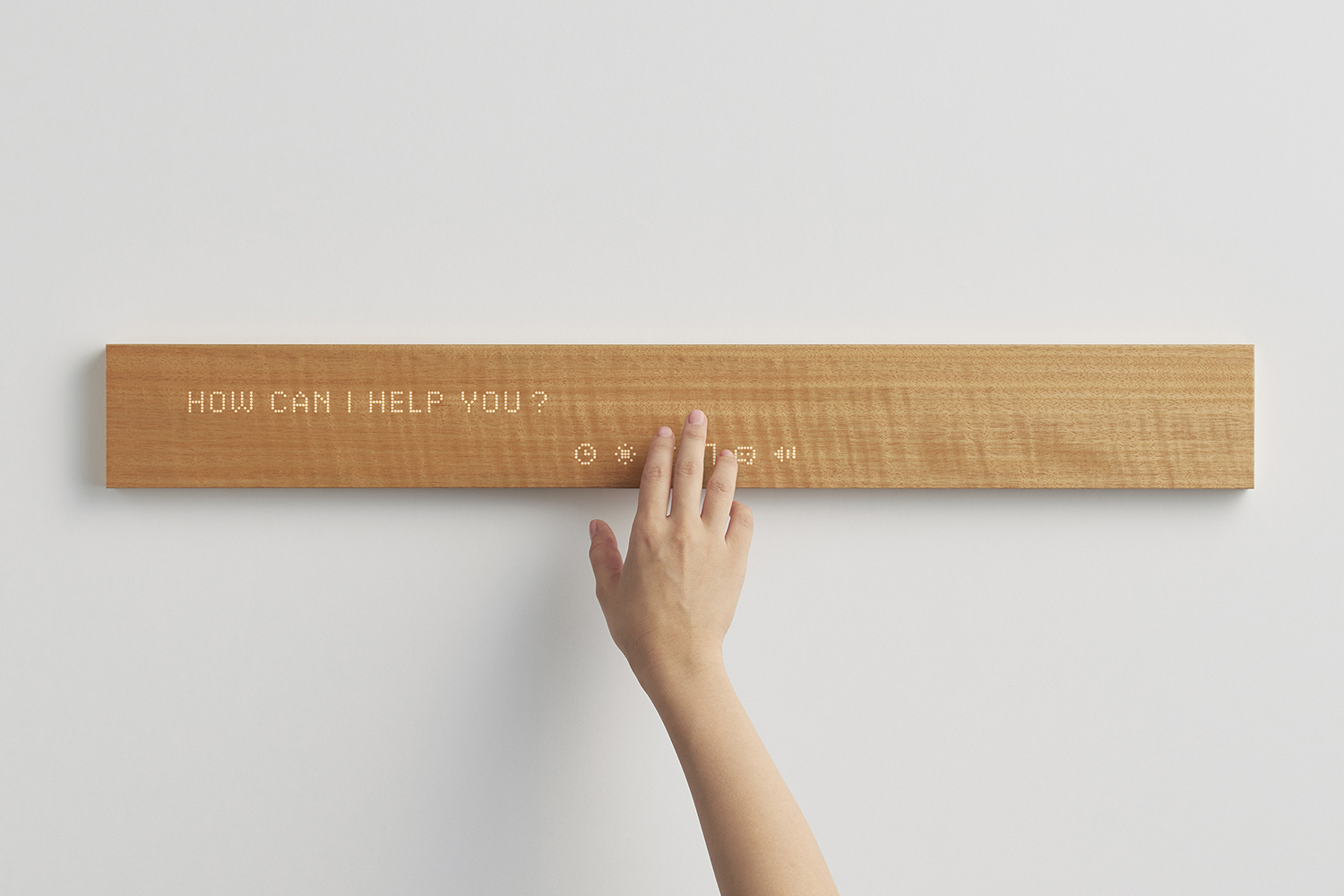‘MUI’ OR ‘NO INTENTIONAL ACT’ IN JAPANESE, IT IS DESIGNED TO POSSESS THE PHYSICAL APPEARANCE AND FUNCTIONALITY THAT EMBODIES THE MEANING OF SUCH A WORD, ITS RECTANGULAR SHAPE IS SO SIMPLE THAT NO ONE WOULD CONSIDER THAT THIS PIECE OF WOOD IS ACTUALLY A TECHNOLOGICAL TOOL WITH A GREAT VARIETY OF FUNCTIONS.
TEXT: SUDAPORN JIRANUKORNSAKUL
PHOTO COURTESY OF MUI LAB
(Scroll down for English)
นอกเหนือไปจากอุตสาหกรรมสมาร์ทโฟนแล้ว อีกหนึ่งในสนามรบสำคัญที่น่าจับตามอง ก็เห็นจะเป็นเหล่า smart home gadget หรืออุปกรณ์อัจฉริยะภายในบ้าน ซึ่งถูกพัฒนาขึ้นเพื่ออำนวยความสะดวกสร้างความสบายให้แก่ผู้ใช้งาน โดยผู้เล่นหลักๆ ในกลุ่มธุรกิจประเภทนี้คงหนีไม่พ้นกลุ่มบริษัท GAFA อันประกอบไปด้วย Google, Apple, Facebook และพี่ใหญ่อย่าง Amazon ที่พวกเขาส่งปัญญาประดิษฐ์มาแข่งขันกันในสมรภูมิที่ว่านี้ ไม่ว่าจะเป็น Google Home, Homepod, Portal และ Alexa หากข้ามมาฝั่งเอเชีย เมื่อพูดถึงเรื่องความเก๋าเกมและล้ำลึกในเรื่องเทคโนโลยีแล้ว ญี่ปุ่นก็ยังคงเป็นประเทศแรกๆ ที่ใครต่างนึกถึง ล่าสุด ผู้ผลิตสัญชาติญี่ปุ่นจากเกียวโตอย่าง mui Lab ก็ส่งอุปกรณ์อัจฉริยะมาลงชิงชัยในสนามรบแห่งนี้ในนาม ‘mui’ ด้วยเช่นกัน
‘mui’ ที่ในภาษาญี่ปุ่นแปลว่า ‘สงบนิ่ง’ นั้น ได้รับการออกแบบให้มีรูปลักษณ์และการใช้งานคล้ายกับความหมายของมัน บนแนวคิดของการกลับคืนสู่ธรรมชาติ ตั้งแต่เรื่องรูปร่างหน้าตา ซึ่งหากมองย้อนกลับไปในกลุ่มผู้เล่นหลักข้างต้น พวกเขามุ่งไปกับการพัฒนาผู้ช่วยอัจฉริยะเหล่านั้นให้ทำงานได้ฉลาดมากขึ้น พร้อมฟอร์มที่แม้จะเรียบง่าย แต่ก็ยังดูทันสมัยและเตะตา

ในทางตรงกันข้าม ‘mui’ มาในรูปทรงสี่เหลี่ยมผืนผ้าหน้าตาเรียบสุดๆ แบบที่ดูเผินๆ คงไม่มีใครคิดว่าแผ่นไม้ที่เหมือนของตกแต่งผนังชิ้นนี้คือ digital display ที่มีฟังก์ชั่นหลากหลายแบบ ทั้งการเป็นอุปกรณ์สื่อสารสำหรับคนในครอบครัวผ่านการรับ-ส่งแมสเสจและข้อความเสียง และความสามารถในการสั่งการไปยังสมาร์ทดีไวซ์อื่นๆ ที่ติดตั้งไว้ภายในบ้าน เป็นต้นว่า การเปิด-ปิด หรือหรี่แสงสว่างภายในห้อง การควบคุมอุณหภูมิผ่านเครื่องเทอร์โมสตัท การเชื่อมต่อกับอุปกรณ์ทั้ง Google Home, Amazon Echo, Nest, Sonos, Philips Hue และ IKEA TRÅDFRI ไปจนถึงการแจ้งเตือนกิจกรรมต่างๆ ที่ผู้ใช้ตั้งค่าในปฏิทินส่วนตัว หรือการแสดงข้อมูลพื้นฐาน ทั้งวัน เวลา สภาพอากาศ การรายงานข่าวสารรอบตัว โดยตัวเครื่องยังมีการติดตั้งแผง capacitive touch และเซนเซอร์บลูทูธที่สามารถเช็คได้ว่ามีคนอยู่ในพื้นที่หรือไม่จากการตรวจจับปริมาณคาร์บอนไดออกไซด์ที่ถูกปล่อยออกมาจากร่างกายได้อีกต่างหาก

ผู้ร่วมก่อตั้ง mui Lab อย่าง Kaz Oki เล่าถึงที่มาของการพัฒนางานชิ้นนี้ของพวกเขาว่า mui Lab ต้องการออกแบบผลงานที่ย้ำเตือนผู้คนว่า เราสามารถกลับคืนสู่ธรรมชาติ สู่ความเรียบง่าย พร้อมทั้งรู้สึกสงบผ่อนคลาย ขณะที่ยังสามารถมีปฏิสัมพันธ์กับคนรอบข้างได้ โดยไม่จำเป็นจะต้องหันหลังให้กับเทคโนโลยี จากการออกแบบฟอร์ม วัสดุ หรือการแสดงผลเท่าที่จำเป็นขณะที่มีการใช้งาน และเมื่อหน้าที่ของมันจบลง ก็กลับสู่การเป็นของตกแต่งหน้าตาเกลี้ยงเกลา ดูเป็นมิตร และถ่อมตน ซึ่งเป็นสิ่งที่ทำให้ mui แตกต่างไปจากอุปกรณ์อัจฉริยะอื่นๆ หากใครมีโอกาสได้คลิกเข้าไปดูวิดีโอที่ mui Lab นำเสนอผลงานชิ้นนี้ของพวกเขา บางทีอาจจะรู้สึกแบบเดียวกับเราว่าแผ่นไม้ชิ้นนี้ไม่ต่างไปจากเพื่อนเก่าเพื่อนแก่ที่ทั้งฉลาดเฉลียว เป็นคนคอยดูบ้านให้ เล่าความเป็นไปที่เกิดขึ้นรอบตัว และในเวลาเดียวกัน ก็ให้เราได้มีชีวิตนอกขอบเขตของเทคโนโลยีแบบที่ควรจะเป็น

With the exception of the smartphone industry, one of the most engrossing battle fields of today’s consumer products is that of the smart home gadgets, which has been developed to facilitate greater living conveniences and experiences for contemporary homeowners. The key players in this particular business sector, are none other than the GAFA giants namely Google, Apple, Facebook and the mogul Amazon, who have been continually developing and releasing their AI technology into the market, from Google Home, Home-pod, Portal to Alexa. If we move over to Asia, Japan still reigns as the country with the most progressive smart home technologies. The recent move comes from the Kyoto-based mui Lab who sends ‘mui’ to fight in this increasingly fiery battle.
Like its name, ’mui’ or ‘no intentional act’ in Japanese (comes from Taoism, that called “wu wei” in Chinese,) it is designed to possess the physical appearance and functionality that embodies the meaning of such a word. From it’s the return-to-nature concept, to the product’s materialized look. If we were to look at the aforementioned key players, the main focus they all share is, the attempt to develop a more proficient and smarter assistant. The form is designed to look simple yet modern and visually appealing.

Its rectangular shape is so simple that no one would consider that this piece of wood is actually a technological tool with a great variety of functions. It offers technology that allows home owners to communicate through the sending and receiving of texts and voice messages, while the system itself is able to command other installed devices such as the house’s lighting system, temperature control (done via thermostat), not to mention its ability to connect to Google Home, Amazon Echo, Nest, Sonos, Philips Hue and IKEA TRÅDFRI, including the display of the activities marked on a user’s personal calendar. The system is also developed to show basic information such as the day, time, weather forecasts and updates on daily incidents. ‘mui’ also has a capacitive touch circuit with a bluetooth censor that detects the presence of people within the living space from the carbon dioxide that we emit.

The co-founder of mui Lab, Kaz Oki talks about the origins of this products development and how the brand wanted to create a product that reminds people of the simplicity and reconnection to nature. Users are able to experience a sense of tranquility, and relaxation while maintaining interactions with other dwellers. The form, materials and display of the processed data are only active when the panel is tapped before returning to sleep mode. Its humble existence in a living space is in the form of a minimal-looking decorative item, making mui different from other smart devices we’ve seen. Check out the link to see mui Lab’s presentation of the project, witness how this technological innovation disguised as a simple-looking wooden panel will make you feel like you have an old friend who looks after your house and informs you about the recent news and weather forecasts. This interactive wooden display offers these conveniences while also allowing users to excuse themselves from the imposing presence of technology at the same time.

